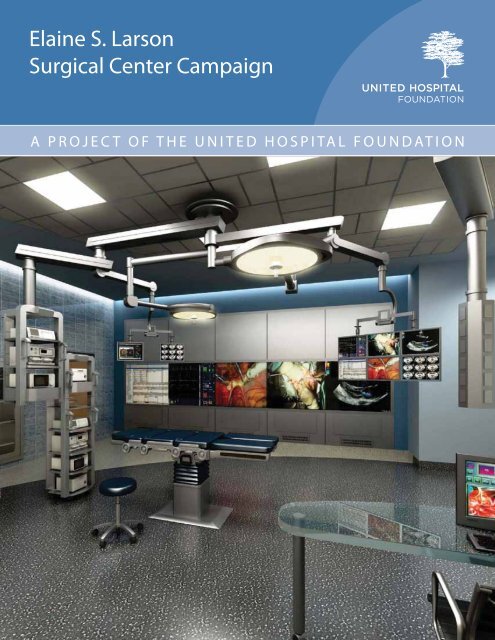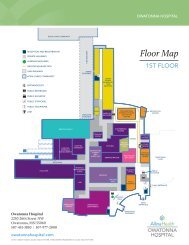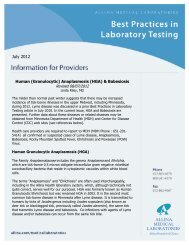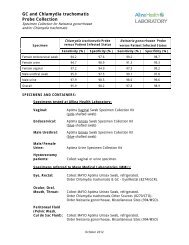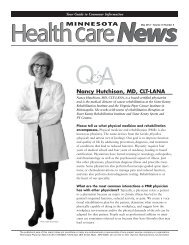Elaine S. Larson Surgical Center Campaign - Allina Health
Elaine S. Larson Surgical Center Campaign - Allina Health
Elaine S. Larson Surgical Center Campaign - Allina Health
Create successful ePaper yourself
Turn your PDF publications into a flip-book with our unique Google optimized e-Paper software.
<strong>Elaine</strong> S. <strong>Larson</strong><br />
<strong>Surgical</strong> <strong>Center</strong> <strong>Campaign</strong><br />
UNITED HOSPITAL<br />
FOUNDATION<br />
A ProjECt of thE UnitEd hoSPitAL foUndAtion<br />
1
table of Contents<br />
Importance of Surgery at United Hospital . . . . . . . . .1.<br />
United Hospital Foundation’s Commitment . . . . . . . .2<br />
Executive Summary . . . . . . . . . . . . . . . . . . . . . . . . . . . . . .3<br />
Hospital Economics . . . . . . . . . . . . . . . . . . . . . . . . . . . . . .5<br />
Today’s Surgery . . . . . . . . . . . . . . . . . . . . . . . . . . . . . . . . . .7<br />
Patient Story . . . . . . . . . . . . . . . . . . . . . . . . . . . . . . . . . . . .9<br />
Financial Summary . . . . . . . . . . . . . . . . . . . . . . . . . . . . . 1.1.<br />
Building for the Future . . . . . . . . . . . . . . . . . . . . . . . . . 1.2<br />
Current Operating Rooms . . . . . . . . . . . . . . . . . . . . . . 1.4<br />
Operating Room Renderings . . . . . . . . . . . . . . . . . . . . 1.6
the importance of Surgery<br />
at United hospital<br />
United Hospital is the hospital of choice for more than 200,000 people<br />
who rely on it each year for their health care needs. Our goal is to provide<br />
any patient, at any time and in any room, with immediate access to the<br />
health care that he or she needs. United’s operating rooms, which were<br />
designed and built in 1977 when procedures were much simpler, are<br />
interfering with our ability to meet this goal. These rooms are antiquated<br />
and undersized, contributing to inefficiencies, financial constraints and<br />
patient, physician and staff dissatisfaction.<br />
Throughout the past 150 years we have shown that we are dedicated<br />
to the health and well being of those in the United community. More<br />
recently, we have made major investments in technology, including<br />
intraoperative magnetic resonance imaging, two robotic surgery systems,<br />
a 3T MRI and the magnetoencephalography, among others. We have<br />
invested in our facilities to improve service and expand specialty care<br />
offerings on our campus through United’s Peter J. King Emergency Care<br />
<strong>Center</strong>, Nasseff Heart <strong>Center</strong> and Nasseff Neuroscience <strong>Center</strong>. We now<br />
need to invest in our operating rooms.<br />
The United Hospital Foundation campaign to completely rebuild<br />
the operating rooms has a goal of $18.5 million. The project<br />
entails restructuring our existing operating rooms into larger, more<br />
technologically advanced surgical suites that will increase efficiencies in<br />
usage, patient flow and turnover. The average size will go from 350 square<br />
feet to 600 square feet.<br />
Please consider joining us in our efforts to serve our communities by<br />
providing exceptional care, as we prevent illness, restore health and<br />
provide comfort to all who entrust us with their care.<br />
Thank you for your commitment to United Hospital and to the United<br />
Hospital community.<br />
Omer Sanan, MD<br />
Medical Director of <strong>Surgical</strong> Services<br />
United Hospital<br />
omer Sanan, Md<br />
1
2<br />
the United hospital foundation<br />
the United hospital foundation recognizes that for United hospital to continue meeting the needs of the<br />
community and of the practitioners who provide the expert care, the Surgery department needs to be<br />
rebuilt, including renovating the existing operating rooms. in 2011, United hospital foundation launched<br />
a campaign toward this goal. Some of the board members opted to get up close and personal with the<br />
situation by touring the facilities and observing a surgical procedure. their experiences highlight the need<br />
for this project.<br />
joan thompson, Minnesota Wire<br />
Thompson oversaw a neurosurgical procedure that involved replacement of a metal<br />
plate in the patient’s spine. “I was left with an excellent impression of the surgeon, Dr.<br />
Jerone Kennedy, and his inclusion of the skilled staff in the room. There were more<br />
than 13 people who came into and out of the room during the five-hour procedure,”<br />
said Thompson.<br />
“The room was cramped, and it was apparent that efficiencies were difficult to achieve,<br />
including moving equipment as needed. At one point technicians had to lay on the<br />
floor under the patient to continue checking on all the wires needed to monitor the<br />
patient.” She noticed inefficiencies in the way inventory was presented during the<br />
procedure and the storage of medical equipment in the hallways. “Improving the space<br />
in the <strong>Surgical</strong> <strong>Center</strong> will provide for the physicians and staff to do their absolute<br />
best work. Patients at United Hospital deserve that,” Thompson said.<br />
russell King, King Capital Corporation, Board Secretary<br />
King observed several hours of a complex neurosurgical procedure that took more<br />
than 23 hours in total. He said he never felt that the room had a direct impact on the<br />
patient’s outcome, and that he wasn’t expecting any impact based on the expertise of<br />
the physician and staff. He was struck, however, by the amount of “clutter” outside the<br />
room. “It was almost oppressive, with all the carts, equipment, gurneys in the hallway.<br />
I could see that this would impact the workflow, adding to the challenges for those<br />
who work in this environment every day.”<br />
“Everything comes back to the fact that United Hospital is a community resource,<br />
with the operating rooms at its core,” he said. “United is a community resource that<br />
needs to be the best it can be.”<br />
dan Mott, fredrikson & Byron<br />
Mott observed a half day of spinal fusion surgery from a step stool. He said the layout<br />
of the room looked like it was out of the 1960s and 70s and very small, given the size<br />
of the equipment used. “It was like buying a house with green shag carpeting; the<br />
presentation was not great,” Mott said.<br />
United’s operating rooms need to be modern and up-to-date. “I saw first-hand that<br />
to provide 21st century care, our surgeons and caregivers need space that is larger and<br />
can be adaptable,” Mott explained. “This will allow us to provide the highest level of<br />
care for patients.”
the 21st Century operating room<br />
Meeting the Community’s needs<br />
Patients at United Hospital have come to expect<br />
high-quality performance, precision and expertise<br />
from our physicians and staff. They know when they<br />
need surgery, United will provide exceptional care.<br />
But this ability is being tested. United’s operating<br />
rooms are too small and too antiquated for today’s,<br />
as well as tomorrow’s, state-of-the-art technology<br />
and capabilities. The fact that our physicians and<br />
staff have continued to provide quality, exceptional<br />
health care in undersized and antiquated facilities<br />
is a testimony to their knowledge, expertise and<br />
dedication.<br />
The majority of United Hospital’s 20 operating rooms<br />
were built in the late 1970s, before the advent of<br />
electronic medical records, portable ultrasound units,<br />
image-guided systems, robotic devices and many other<br />
technological advances that have improved surgical<br />
precision and results. Surgeons and staff often find<br />
themselves crowded into small operating rooms, high-stepping cables, maneuvering<br />
between portable carts and devices and often having to manually shift equipment<br />
into and out of the room during procedures. All of which add time, thus incurring<br />
additional costs and reducing efficiencies. In an era of reduced reimbursements and<br />
increased medical costs, efficient use of the surgical spaces is paramount.<br />
In 2010, 10,022 operations were performed at United Hospital in 19 surgical rooms.<br />
(One of the 20 operating rooms is being used for equipment storage). The rooms<br />
vary in size, but average between 315 and 469 square feet. Space restrictions mean<br />
that many procedures can only take place in certain rooms to accommodate the<br />
appropriate equipment.<br />
“United’s operating rooms are half the size they need to be for surgeries of today,”<br />
says Dan Foley, MD, United Hospital’s vice president of medical affairs. “When these<br />
operating rooms were built, surgeries were simple and open. Today most surgeries<br />
require minimal techniques. Anytime you convert to a minimally invasive technique<br />
you need more equipment and additional staff.”<br />
In addition to size limitations, storage issues are rampant. Hallways, a surgical room<br />
and an autoclave room are routinely used for equipment storage. labeled, colored tape<br />
permanently lines the hallway floors marking specific storage sites for equipment, such<br />
as electron microscopes, beds and carts. The labeling helps make it easier to locate a<br />
SURgICAl CENTER CAMPAIgN<br />
Executive Summary<br />
the <strong>Elaine</strong> S. <strong>Larson</strong> <strong>Surgical</strong><br />
<strong>Center</strong> <strong>Campaign</strong> will<br />
completely rebuild United’s<br />
operating rooms into<br />
larger more technologically<br />
advanced surgical suites.<br />
3
4<br />
dan foley, Md, Vice<br />
President Medical Affairs<br />
Bob Plaszcz, Vice<br />
President operations<br />
needed piece of equipment but hampers movement and, in some cases, creates<br />
hazards. This storage solution also means that equipment is manually moved,<br />
sometimes across great distances, which increases the possibility of equipment<br />
damage, as well as injury to staff.<br />
A third issue is turnover. When everything must be moved into and out of<br />
each room, it takes longer following one procedure to remove equipment,<br />
clean the room and bring in what is needed for the next procedure. Surgeons<br />
want to be efficient and will go where they can be assured of doing more cases.<br />
Fourth is technology. Architects who designed United’s operating rooms<br />
40 years ago could not have foreseen the technological advances typical<br />
in today’s surgical procedures. The rooms do not have the technological<br />
infrastructure needed, thus creating inefficiencies, as well as hazards in the<br />
form of cables on the floors, physical restrictions to staff and other safety<br />
problems.<br />
Research has shown that for today’s surgical procedures, operating arenas<br />
should have:<br />
• 600 – 650 square feet for general, orthopedic and cardiac procedures<br />
• 750 square feet for neurosurgery and robotics<br />
• 200 square feet of storage for each operating room<br />
The United Hospital Foundation is spearheading the campaign to rebuild-<br />
United Hospital’s operating rooms. The project includes:<br />
• Reconfiguring 15 operating rooms. Operating suites will be at least<br />
600 square feet in size.<br />
• Ceiling mounted booms for equipment to eliminate floor cabling and<br />
reduce the need for equipment carts or towers.<br />
• Multispecialty functionality for improved patient and surgeon access.<br />
• Technology integration for connectivity issues, making it easier to display<br />
data on one flat panel monitor, and integrate technological platforms,<br />
systems and power outlets.<br />
• Improved lighting.<br />
• Improved storage space.<br />
• Improved flow for both patients and staff.<br />
• Remodeled Doctor’s lounge.<br />
• Sterile processing will be moved to the surgical area from the basement.<br />
“The cost of this remodeling project will be $18.5 million says Bob Plaszcz,<br />
vice president of operations at United Hospital. “When completed, United<br />
Hospital’s operating rooms will meet the needs of our community, our<br />
surgeons and surgical staff.”
Surgery<br />
A hospital’s Economic Engine<br />
Surgery is the economic engine of any hospital. Most<br />
hospital programs and services that are needed to<br />
ensure a community’s continued health and well<br />
being are not economically viable and must rely on<br />
income from surgery to survive. The bottom line of<br />
any surgery department has far-reaching effects on<br />
all other programs.<br />
In an era of diminishing reimbursements for most<br />
medical services, the need is even greater for<br />
hospitals to ensure that their surgery department<br />
is strong, efficient, well-run and healthy. This<br />
includes upgrading surgical processes and facilities as<br />
technology and other advances are made, a goal that<br />
is even more imperative given that every other east metro hospital has<br />
invested in their surgical facilities over the past few years.<br />
To continue to meet the needs of our community, and our physicians and<br />
staff who provide the surgical service, United Hospital must completely<br />
rebuild its operating rooms. These facilities were last updated in the<br />
1970s and were state-of-the-art for that time. Open surgical procedures<br />
have been replaced with minimally invasive techniques that require<br />
more equipment, training and personnel, all crowded into spaces that<br />
are too small and too antiquated. The fact that our physicians and staff<br />
have continued to provide quality, exceptional health care in undersized<br />
and antiquated facilities is a testimony to their knowledge, expertise and<br />
dedication.<br />
Scheduling and turnover Costs<br />
“When you are limited to certain rooms because of space considerations,<br />
access difficulties arise,” says Jerone Kennedy MD, a neurosurgeon with<br />
United Neurosurgery Associates. He also serves as medical director of<br />
Neurosurgery and Bentson Neuroscience Chair at United Hospital. “Such<br />
difficulties mean delays in scheduling and slower turnover.”<br />
“Scheduling is one of the biggest problems with our operating rooms<br />
configuration,” says Pam Berg, RN, surgical patient care manager at<br />
United. “There are only a limited number of rooms that are large enough<br />
for the technology needed today.” In addition, she cites that with the<br />
increase in equipment is an increase in the number of staff in the room.<br />
“The more complex the procedure, the more staff are in the room.”<br />
SURgICAl CENTER CAMPAIgN<br />
hospital Economics<br />
United hospital’s undersized<br />
operating rooms slow down<br />
procedures as equipment is<br />
moved into and out of each room,<br />
thus increasing surgical time and<br />
reducing the number of procedures<br />
that can be completed in a day.<br />
5
6<br />
jerone Kennedy, Md,<br />
neurosurgeon<br />
Pam Berg, rn, <strong>Surgical</strong><br />
Patient Care Manager<br />
Turnover refers to the process of transition from one procedure to the<br />
next. When a procedure is completed, equipment must be moved out<br />
of the room so the room can be cleaned. Then equipment for the next<br />
procedure is brought in. When rooms are small, equipment placement is<br />
similar to putting together a jigsaw puzzle. The pieces need to be placed<br />
in the room in a specific order and precise to each other or they don’t fit.<br />
Sometimes this means, moving the patient in first and the equipment in<br />
afterwards. In addition, equipment may be stored in a location far from<br />
the room, slowing turnover even more.<br />
“United has longer turnaround times than elsewhere,” says Dr. Kennedy.<br />
“Surgeons who could do four or five cases in a day elsewhere may only fit<br />
in two or three at United.”<br />
By renovating the operating rooms, many of these inefficiencies will be<br />
eliminated, such as competition for the few large operating rooms that<br />
currently exist. Delays in scheduling will be reduced and scheduling staff will<br />
have less juggling to do. Turnover time will also be reduced, as much of the<br />
equipment will be mounted on booms in the rooms, reducing the need for<br />
carts to be moved to and from the room. Storage will be increased, making it<br />
easier to locate equipment and supplies when needed.<br />
Process improvement<br />
In addition to the physical renovation, work began in January 2010 on<br />
process improvements for the Surgery Department. For example,<br />
perioperative staff and post-surgical staff have been trained to float<br />
between these two areas so that staff is readily available to meet the<br />
greatest need. Additional studies are underway regarding supply<br />
distribution to reduce supply costs, improve inventory and make supplies<br />
easier to access during a procedure.<br />
“The supplies and equipment you use over and over should be centrally<br />
located to decrease down time,” says Dr. Kennedy. “If you don’t address<br />
process improvement, utilization and flow, you won’t improve efficiency.”<br />
And without improved efficiency, the bottom line will be affected, as will<br />
all other programs at the hospital.<br />
Strategic Growth<br />
United Hospital has strategically planned to increase surgical cases<br />
based on the community’s need and growth for the hospital. The current<br />
operating rooms interfere with that ability and can impact every other<br />
program and service at United Hospital.
the Growth of Minimally invasive Surgery<br />
Changing how Surgery is done<br />
In the 1970s, when United Hospital’s operating rooms were last<br />
updated, one of the most common surgical procedures was an open<br />
hysterectomy. little equipment was needed outside of handheld tools,<br />
strong lights and a table. Rooms that were 350 to 400 square feet were<br />
perfectly adequate for such procedures.<br />
Advances in medicine and technology throughout the past 40<br />
years have changed the types of procedures and the way surgery is<br />
being done. Many formerly open procedures have been replaced<br />
by minimally invasive procedures. Such procedures mean smaller<br />
incisions, faster recovery times, reduced hospital stays and less blood<br />
loss for the patients and improved accuracy, precision and capabilities<br />
for the surgeons. Conditions that led to open hysterectomies, for<br />
example, now are often treated with medication, eliminating the need<br />
for surgery altogether. For those patients with more complex cases who<br />
need surgery, the procedures are being done laparoscopically or via<br />
robot. What used to be five to seven day hospitalization stay is now<br />
two to three days. Recovery is three to four weeks versus six to eight<br />
weeks. good news for the patient.<br />
“The more minimally invasive the procedure, the more likely the<br />
need for additional equipment,” says Peter D. Sershon, MD, director<br />
of the Minnesota Robotic Surgery <strong>Center</strong> at United Hospital. “This<br />
equipment is stored on carts or towers. These towers are moved into<br />
and out of each room, creating a maze and interfering with line of<br />
sight and movement of staff.”<br />
the Benefits of Minimally invasive Surgery<br />
Although every patient and every surgery is unique, minimally<br />
invasive surgery offers important advantages for patients, including:<br />
• Smaller incisions and less scarring<br />
• less pain and discomfort<br />
• Shorter hospital stay<br />
• Quicker recovery<br />
• less blood loss and fewer transfusions<br />
• Fewer side effects and complications<br />
• Reduced risk of infection<br />
• Better outcomes<br />
continued on next page<br />
SURgICAl CENTER CAMPAIgN<br />
today’s Surgery<br />
United hospital’s da Vinci® <strong>Surgical</strong><br />
System, funded by United hospital<br />
foundation.<br />
7
810<br />
Peter Sershon, Md,<br />
director of the Minnesota<br />
robotic Surgery <strong>Center</strong> at<br />
United hospital<br />
robotic Surgery<br />
continued from previous page<br />
robotic surgery is performed using advanced technology known<br />
as the da Vinci ® <strong>Surgical</strong> System. the doctor sits at a console near<br />
the patient, using hand and foot pedals to control four robotic arms<br />
that hold micro-instruments and a miniature camera. the special 3d<br />
camera projects a color image to the console, giving the surgeon a<br />
view magnified 10 times.<br />
the da Vinci robot is essentially an extension of the surgeon’s hands<br />
and eyes, with the surgeon initiating and controlling every movement.<br />
the robot perfectly duplicates the actions of the surgeon; it does<br />
not perform the surgery by itself. the tips of the robotic arms rotate<br />
like the human wrist, allowing surgeons to use many of the same<br />
techniques they learned for open surgery. robotic technology gives<br />
surgeons more flexibility, increased precision and greater reach even<br />
while operating through tiny incisions.<br />
in october 2010, United hospital added a second da Vinci robotic<br />
system, funded by United hospital foundation. the demand for these<br />
minimally invasive procedures is growing and the possibilities for<br />
additional usage, such as in bariatrics and gynecological procedures,<br />
is expanding. in addition, United has created the da Vinci Epicenter<br />
for Women’s health and Gyne cology, which offers surgeons the<br />
opportunity to learn the art of advanced robotic-assisted surgeries.<br />
it is one of only 23 centers nationwide and provides training that<br />
demonstrates the depth, comprehensiveness and best practices of<br />
the da Vinci <strong>Surgical</strong> System program.<br />
“Patients are aware of these benefits,” says Dr. Sershon. “They come in<br />
with the knowledge about minimally invasive and robotic procedure,<br />
which will only increase the demand for these procedures.”<br />
A market analysis of the growth of minimally invasive surgery shows a<br />
predicted 8.3 percent increase in growth every year for the next five years,<br />
according to a 2009 report from Bharat Book Bureau. 1<br />
The benefits and advancing technology guarantee that minimally<br />
invasive procedures will be the norm and open procedures the exception.<br />
Operating rooms designed with this in mind will be capable of meeting<br />
today’s demand, as well as meet the needs of the future.<br />
RefeRence<br />
1. “Minimally Invasive and Non Invasive Surgery Market,” 2009,<br />
Bharat Book Bureau. www.bharatbook.com/Market-Research-Reports/<br />
Minimally-Invasive-and-Non-Invasive-Surgery-Market.html.<br />
robotic surgery is quickly becoming the<br />
preferred method for many common surgical<br />
procedures —with some physician groups<br />
at United hospital using it for 97 percent of<br />
the surgeries they perform. the innovative<br />
da Vinci system makes it possible for doctors<br />
to perform complex and delicate procedures<br />
that were impossible just a few years ago<br />
without more invasive open surgery.
obotic removal of Uterine fibroids<br />
jeannette Wittrock’s story<br />
During her annual physical exam, Forest lake resident Jeannette Wittrock<br />
talked with her family physician about her heavy, long menstrual bleeding.<br />
She had uterine fibroids, noncancerous tumors of the uterus, a condition<br />
that often runs in the family. Her symptoms were severe enough to<br />
warrant surgery, so her doctor referred her to gerald Cunniff, MD, a<br />
surgeon who specializes in the robotic treatment of uterine diseases.<br />
Robotic surgery is performed using the advanced technology known as the<br />
da Vinci ® <strong>Surgical</strong> System. The surgeon sits at a console and uses hand<br />
and foot peddles to control four robotic arms that hold micro-instruments<br />
and a miniature camera. The surgeon views the surgery through a<br />
3-dimensional camera that magnifies the view 10 times.<br />
The advantages of the robotic-assisted surgery are improved accuracy,<br />
precision and control for the surgeon and reduced pain, discomfort, blood<br />
loss and side effects for the patient. Studies have shown that roboticassisted<br />
surgery has better outcomes than traditional open surgery.<br />
“The primary advantage of robotic surgery is that it is less invasive,” says<br />
Dr. Cunniff, an obstetrician and gynecologist at <strong>Allina</strong> Medical Clinic –<br />
Parkview OB/gYN in Eagan, Minn. “Because it is less invasive, recovery<br />
time is greatly reduced. In a traditional open procedure, the patient<br />
typically stays in the hospital three to four nights and then has a six-week<br />
recovery before she can return to work. With the robotic procedure, the<br />
hospital stay is usually overnight, and she can return to normal activity in<br />
two to three weeks.”<br />
<strong>Surgical</strong> treatment for uterine fibroids can include myomectomy, removal<br />
of the fibroids themselves, or hysterectomy, removal of the uterus, if the<br />
condition is severe. Because of Wittrock’s condition and symptoms, a<br />
hysterectomy was recommended.<br />
continued on next page<br />
SURgICAl CENTER CAMPAIgN<br />
Patient’s Story<br />
Gerald Cunniff, Md<br />
9
10 12<br />
robotic hysterectomy<br />
Wittrock had read about a woman who underwent a robotic-assisted<br />
hysterectomy in a community newsletter and was glad to learn that she was<br />
a candidate for the procedure. She had the procedure in early May, and her<br />
recovery has been good.<br />
“I knew others who had hysterectomies, and it seemed that the recovery and the<br />
surgery were better with the robot,” says Wittrock, who is 49. “I was only in the<br />
hospital overnight, and just two weeks after my procedure, I was feeling pretty<br />
good.”<br />
Wittrock adds that she experienced minimal pain that was easily controlled<br />
with over-the-counter medication. She was able to return to her normal activity<br />
relatively quickly and reports that four weeks after surgery she was back to<br />
walking the dogs three to four miles a day.<br />
da Vinci Epicenter for Women’s <strong>Health</strong> and Gynecology<br />
teaching robotic-Assisted Surgery<br />
continued from previous page<br />
Surgeons from anywhere in the country now have the opportunity to<br />
train in advanced robotic-assisted surgeries at the da Vinci Epicenter<br />
for Women’s health and Gynecology at United hospital. this new<br />
center focuses on women’s health and gynecology and is the first in<br />
Minnesota.<br />
the center is one of only 20 nationwide and provides training that<br />
demonstrates the depth, comprehensiveness and best practices<br />
of the da Vinci ® <strong>Surgical</strong> System program for minimally invasive<br />
myomectomies, hysterectomies and sacrocolpopexies.<br />
the center’s training surgeons are board-certified obstetrics and<br />
gynecology surgeons ragnvald (ron) Mjanger, Md, fACoG, and Eric<br />
English, Md, fACoG.<br />
dr. Mjanger and dr. English practice at United hospital and Metro<br />
oB/GYn. dr. Mjanger performs minimally invasive myomectomies,<br />
hysterectomies and sacrocolpopexies and specializes in the treatment<br />
of pelvic prolapse and urinary incontinence. dr. English practices<br />
within the full range of obstetrics and gynecology and performs high-<br />
and low-risk obstetrical care and focuses on minimally invasive surgical<br />
techniques, from transvaginal pelvic prolapse repair to hysterectomies.<br />
in october 2010, United hospital purchased<br />
its second robotic system through funding<br />
from the United hospital foundation.
Budget and funding Sources for the Project<br />
Budget<br />
Construction..................................................................$15,000,000<br />
Design..............................................................................$1,000,000<br />
Fixtures, furniture and equipment....................................$2,500,000<br />
funding Sources<br />
$18,500,000<br />
<strong>Allina</strong>...............................................................................$7,000,000<br />
United Hospital Foundation.......................................... $11,500,000<br />
$18,500,000<br />
To support the elaine S. <strong>Larson</strong> <strong>Surgical</strong><br />
center campaign, please contact the<br />
United Hospital foundation at<br />
651-241-8022 or unitedhospital.com/<br />
unitedfoundation.<br />
SURgICAl CENTER CAMPAIgN<br />
financials<br />
11
12<br />
future of Surgery<br />
A thoughtful design<br />
Just as designers in 1970 couldn’t envision robotic surgical procedures<br />
in 2011, it is hard to predict where surgery may be in 2050. However,<br />
there are indications regarding the future of surgery.<br />
“Advances in surgical technology and knowledge are like advances<br />
in computers today,” says William Rupp, MD, medical director of the<br />
Bariatric <strong>Center</strong> at United Hospital. “Changes are going to be rapid<br />
and continuous, and we need to stay at the forefront. Adapatability is a<br />
huge part of any redesign of the operating venue.”<br />
For instance, Dr. Rupp sees the training of surgeons evolving to become<br />
more and more specialized. “As surgeons become more narrowly<br />
focused, they will need to be able to consult with their peers more<br />
rapidly and more quickly, even in the midst of a procedure.”<br />
The technology for live, videoconferenced consultations already exists<br />
and is referred to as telehealth. Through a telehealth system, physicians<br />
consult live over the Internet with specialists who may be located in<br />
another room, another hospital or another state. In August 2010, the<br />
<strong>Allina</strong> Telehealth Network was launched. It currently provides 24-hour<br />
access for regional hospitals to neuroradiologists and interventional<br />
neuroradiologists at <strong>Allina</strong> for consultations in cases of stroke. The<br />
potential for expansion of this technology is enormous, and Dr. Rupp sees<br />
its value in the operating room.<br />
“Telehealth features need to be fully integrated in the operating rooms,”<br />
says Dr. Rupp. “Imagine the advantages of immediate consultation with<br />
other experts that such a system would provide.”<br />
More robotic Procedures<br />
Dr. Rupp also sees the continued growth of minimally invasive<br />
procedures, in particular the rapid adoption of robotic techniques in<br />
areas beyond what is currently being practiced.<br />
“Robotic technology is still in its infancy,” he says. “Its use and<br />
capabilities are only going to continue to change rapidly.” He cites, for<br />
instance, recent forays by surgeons using robotic surgery in the treatment<br />
of pancreatic disease.<br />
And as demand for robotic procedures grows, so will competition for<br />
access to the technology.<br />
William rupp, Md
A hybrid Concept<br />
The goal of any redesign of an operating venue should always be what is best for the<br />
patient and will ensure the best outcomes from the procedures. Studies have shown that<br />
for a design to evolve into the future, it must be flexible, adaptable and multidisciplinary.<br />
Such an operating room is often described as a hybrid room, which allows for quick<br />
conversion into the arena needed for a particular procedure. A study by Philips and<br />
Skytron, hybrid surgical room manufacturers, states, “A hybrid surgical suite delivers the<br />
enhanced ability to efficiently perform both minimally invasive procedures and open<br />
surgery with the imaging support and surgical tools that the surgeon and surgical team<br />
requires.” 1<br />
Growth of Surgery<br />
“The <strong>Surgical</strong> <strong>Center</strong> <strong>Campaign</strong> is a strategic project, designed to help United Hospital<br />
and grow surgical opportunities,” says Omer Sanan, MD, medical director of surgical<br />
services at United Hospital. “We need to grow our surgery volumes. We need to reach<br />
out to our community base to let them know that United Hospital has the facilities they<br />
need, when they need them.”<br />
The United Hospital Strategic Plan recognizes that future trends in surgery will occur in:<br />
• heart<br />
• orthopedics<br />
• bariatrics<br />
• robotics<br />
• neurology and spine<br />
RefeRence<br />
1. “Optimizing workflows & efficiency with digital OR integration,”<br />
Executive <strong>Health</strong>care, www.executivehm.com/article/<br />
Optimizing-workflows--efficiency-with-digital-OR-integration/<br />
13
SURgICAl CENTER CAMPAIgN<br />
Current View of the operating rooms<br />
14<br />
Current View of the operating room<br />
United Hospital’s operating rooms, which average between 315<br />
and 469 square feet, are too small for today’s minimally invasive<br />
procedures. Today’s community standard for an operating room is<br />
approximately 600 square feet.<br />
The images on this page were taken on a typical day in the United<br />
Surgery Department.<br />
Images on the following pages show preliminary architect drawings<br />
for the new surgical center.
SURgICAl CENTER CAMPAIgN<br />
Architect’s renderings*<br />
Patient waiting area<br />
Physician lounge<br />
16<br />
hallway to the <strong>Elaine</strong> S. <strong>Larson</strong><br />
<strong>Surgical</strong> <strong>Center</strong><br />
*renderings by hdr
operating room<br />
United <strong>Surgical</strong> <strong>Center</strong> floorplan<br />
renderings by hdr<br />
17
333 Smith Avenue North<br />
Saint Paul, MN 55102<br />
651-241-8022<br />
unitedhospital.com/unitedfoundation<br />
the United hospital<br />
foundation exists to<br />
enhance the health of<br />
United hospital patients<br />
and the wellness of the<br />
community we serve.


